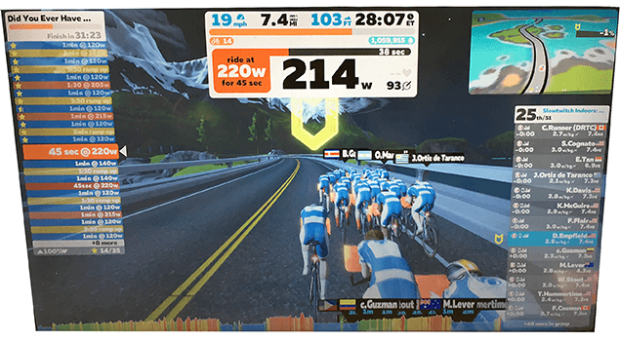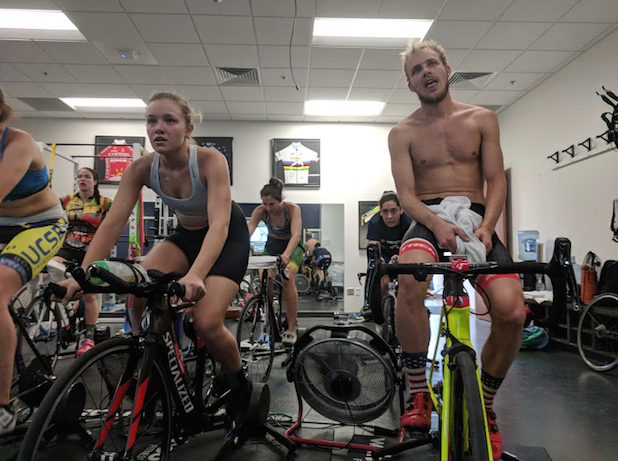It’s a VirtuGo-a-Go-Go!
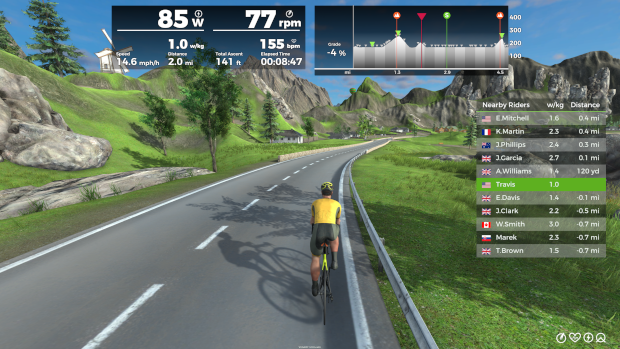
In today’s indoor training landscape, we have a lot of good options to entertain and train – or as I like to describe it, “entertrain”. In the last few years, we have witnessed the rise of several really strong players such as Zwift, TrainerRoad, Rouvy, and The Sufferfest establish their place on the spectrum of structured training and entertainment. Some products – TrainerRoad, Golden Cheetah, PerfPRO Studio – appeal to those dedicated souls who are intrinsically motivated by structured training and seeing the results on race day. Others – Zwift, Tacx, Rouvy, The Sufferfest – may have more appeal to those who are extrinsically motivated by the visual and social aspects of training. No matter where you lie on that spectrum, there are products for you, and the options and quality of these tools are developing at a breakneck pace.
Today, we’re looking at VirtuGO, a relatively new player in the indoor training space that has its roots in providing solid and scientific structured training combined with entertaining visuals. In this introduction, we’re going to look at what makes VirtuGO stand out.
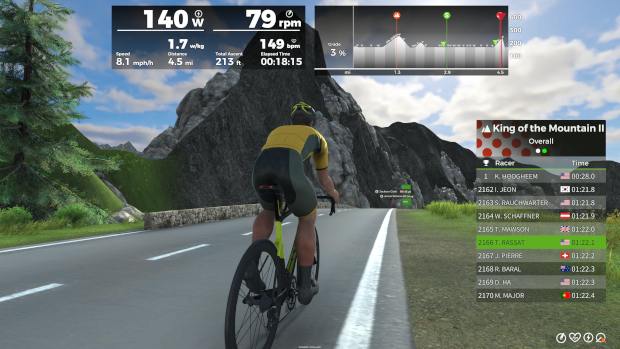
Welcome to Pulseville
VirtuGO is a MMO (Massive Multiplayer Online) game, similar to Zwift or RGT (formerly RoadGrandTours), in which you are rendered as an avatar riding through a virtual world. VirtuGO’s user interface is clean and intuitive – the startup, login, and main menu make it easy to get in, select your ride, customize your avatar, pair up your sensors, and get your legs moving.
During the ride, the interface utilizes the familiar Head’s Up Display (HUD) approach similar to Zwift, Rouvy, and others. All of your information – power output, where you are, who else is riding, etc. – is displayed. VirtuGO’s interface is somewhat simple, with very few keyboard shortcuts, other than using the number keys to toggle between the five camera views.
Here’s a brief demonstration video:
After your ride, you receive a nice performance summary. Strava and TrainingPeaks integration allows you to share your training with your coach or friends. The training aspect is where VirtuGO gets interesting.
The VirtuGO Performance Pathway
At first glance, you might look at VirtuGO as being just another game-like product like Zwift. Visually, that’s a natural comparison. But, what separates VirtuGO is the training foundation. While Zwift has done an OK job of adding in features to make it better as a training platform, VirtuGO is starting there: VirtuGO’s core feature is the collection of power-based workouts and multi-week structured training programs designed to target your performance goals. VirtuGO’s library of training sessions and plans is geared towards building up the rider using solid methods over time according to the physiological aspects of riders and riding disciplines.
VirtuGO calls this their Performance Pathway, and you can read more on it here. VirtuGO breaks down their training sessions and programs in a few different ways, including a Power Profile, cycling disciplines, and training phases.
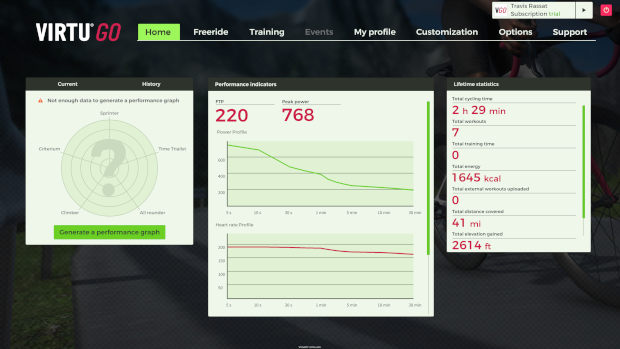
Power Profile
Prominently feaured on VirtuGO's home screen is a graph called your Power Profile. The main objective here is to identify what kind of rider you are, and where your strengths and weaknesses lie. Initially, your Power Profile will be just a big question mark. To develop your Power Profile, just keeping riding in VirtuGO and eventually build it through time and mileage, take a Power Profile Test, or import .FIT files.
The concept of the Power Profile isn’t new, as folks like Andy Coggan and Joe Friel have been thinking beyond FTP and breaking down cycling performance like this for a long time. As far as indoor training software goes, VirtuGO’s implementation is similar to The Sufferfest’s 4DP, in which a rider’s strengths can be better understood through what kind of power they do best – high wattage short sprints to diesel-like steady-state efforts. VirtuGO uses a bit different way of describing it by using cycling discipline terminology.

Cycling Disciplines
VirtuGO uses five cycling disciplines to describe the emphasis on the type of riding:
- Time Trialist
- Climber
- Criterium
- Sprinter
- All Rounder
As the names imply, VirtuGO’s cycling disciplines help identify your strengths and weaknesses in the types of riding you do. The type of rider you are, or the type of rider you want to be, can be influenced and enhanced by utilizing VirtuGO’s training sessions and plans, which are all consistently labeled according to these disciplines.
The last time I looked at The Sufferfest, one criticism I had of 4DP is that, while it did a nice job of helping you know where you were as far as a power source goes, it didn’t necessarily help you understand how to get to where you want to be as a rider. If you are good at 1 second power, how does that translate to how you ride?
By breaking it down by cycling discipline, VirtuGO removes a layer of translation to better inform you of how you can adjust your training to be better where you want to be. If you are a climber, or want to be a better climber, you can choose sessions or plans that are designed for a climber. Maybe you have a triathlon coming up soon, in which you would like to focus on being a better time trialer, so you can train accordingly.
VirtuGO currently provides 33 plans targeted towards the 5 cycling disciplines. Each plan is 4 weeks long, and includes 3 to 5 sessions per week. There are roughly 90 sessions currently available. Pick and choose the sessions you like, or use a plan to guide your training. Sessions can be appropriate for any of the cycling disciplines. Sessions range from 25-100 minutes each, with a majority around the 60 minute mark.
Training Phases
VirtuGO also incorporates training phases to lay the rider’s foundation and build on it. VirtuGO uses the combination of cycling disciplines and time-based training to effect change to your Power Profile. They recognize a 5 phase approach to cycling performance:
- Phase 1: General Endurance Conditioning
- Phase 2: Quality Conditioning
- Phase 3: Specific Conditioning
- Phase 4: Load Accumulation
- Phase 5: Coalescence
These phases are incorporated into the training plans and cycling disciplines, not only from a time perspective, but from a prioritization and goal-orientation perspective. For example, while the All Rounder cycling discipline may sound like a good starting point, it’s more of a Phase 3 or 4 level of training. If you’re establish a training base, the Climber plans/sessions are better for someone that is in Phase 1, so you can choose a Climber plan, and follow it up with a Time Trialist or Sprinter plan, which are more in line with Phases 2 and 3. This interaction between the disciplines and phases is explained in more detail on VirtuGO's website.
It’s easy to compare the VirtuGO Performance Pathway to what has already been done before. For example, TrainerRoad’s greatest strength is their large collection of well-designed workouts and training plans, which they developed early on as a foundation of their product. While VirtuGO certainly doesn’t have the quantity and variety of workouts and plans that TrainerRoad has, they certainly provide a very good foundation – a smart collection of workouts and plans, designed with a proven scientific approach.
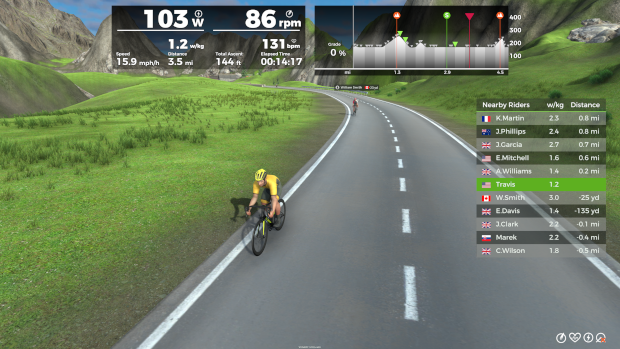
Let’s Get This Party Started!
In order to enjoy your first ride, you’re going to need a lot of the same things we’ve covered in past articles. When it comes to hardware and connecting all the pieces for an indoor training rig, you may want to refer to our first article on Zwift. VirtuGO is going to have a lot of similarities in the setup and implementation, but with a few things of note.
System Requirements
VirtuGO is available for Windows PCs and Macs only. You’ll want a pretty stout system to really enjoy the eye candy, and VirtuGO has a neat tool built-in to determine how well your machine can handle it. The screenshots and videos in this article were done with a pretty powerful PC, running at U4K with the highest settings. Look for another article geeking out on that soon.
No Virtual Power
For your trainer, VirtuGO is somewhat limited in selection. VirtuGO does not support virtual power, so you’ll either need to use a power meter or a smart trainer.
ANT+ and Bluetooth
As of this writing, Bluetooth support is still in beta, but if you have ANT+ devices, you are good to go.
Installation is straightforward – download it and install like you would install any other application. VirtuGO gives you a 10 day free trial, and after than it’s a reasonable €5.95 per month subscription.
The VirtuGO Verdict?
While VirtuGO has established a really solid base at a reasonable monthly subscription cost, it’s hard not to compare it to Zwift and TrainerRoad – it has some of the best elements of each, but is a couple of years behind. With no virtual power or support for iOS or Android devices, it is essentially limited to riders with a smart trainer and a pretty powerful PC in their pain cave. The subscription price is nice, but are the startup costs a limiter?
It’s a bit too soon to come to a conclusion on VirtuGO yet. We’ll do another article or two to explore VirtuGO some more before we come to a conclusion.



